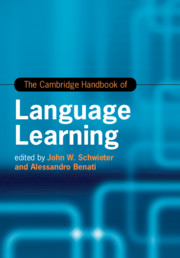Book contents
- The Cambridge Handbook of Language Learning
- Cambridge Handbooks in Language and Linguistics
- The Cambridge Handbook of Language Learning
- Copyright page
- Contents
- Figures
- Tables
- Contributors
- Acknowledgements
- Introduction
- Part I Theories
- Part II Methods
- Part III Skill Development
- Part IV Individual Differences
- Part V Pedagogical Interventions and Approaches
- 20 Pedagogical Interventions to L2 Grammar Instruction
- 21 Task-Based Language Learning
- 22 Task and Syllabus Design for Morphologically Complex Languages
- 23 Proficiency Guidelines and Frameworks
- 24 Technology-Mediated Language Learning
- 25 Content-Based L2 Teaching
- 26 Conceptions of L2 Learning in Critical Language Pedagogy
- Part VI Context and Environment
- Part VII Moving Forward
- Index
- References
21 - Task-Based Language Learning
from Part V - Pedagogical Interventions and Approaches
Published online by Cambridge University Press: 25 June 2019
- The Cambridge Handbook of Language Learning
- Cambridge Handbooks in Language and Linguistics
- The Cambridge Handbook of Language Learning
- Copyright page
- Contents
- Figures
- Tables
- Contributors
- Acknowledgements
- Introduction
- Part I Theories
- Part II Methods
- Part III Skill Development
- Part IV Individual Differences
- Part V Pedagogical Interventions and Approaches
- 20 Pedagogical Interventions to L2 Grammar Instruction
- 21 Task-Based Language Learning
- 22 Task and Syllabus Design for Morphologically Complex Languages
- 23 Proficiency Guidelines and Frameworks
- 24 Technology-Mediated Language Learning
- 25 Content-Based L2 Teaching
- 26 Conceptions of L2 Learning in Critical Language Pedagogy
- Part VI Context and Environment
- Part VII Moving Forward
- Index
- References
Summary
The psycholinguistic rationale proposed for TBLT varies somewhat, but is usually an amalgam of cognitive-interactionist and usage-based theories (see, e.g., Long, 2015a, pp. 30–62; Robinson, 2007, 2015; Skehan, 1998, 2015) developed with language learning as the explanandum. When students are adults, whose capacity for purely incidental learning, especially instance learning, is weaker than in young children, a variety of devices is required to enhance incidental learning and thereby speed up the process. The enhancements seek to help learners either detect or notice new items in the input by increasing their perceptual saliency and by drawing learners’ attention to needed lexis and collocations and grammatical patterns, especially when non-salient forms and form–function or form–meaning relationships are concerned. However, most of the attention-drawing procedures are deployed in response to learner performance, not in advance, as in synthetic approaches.
- Type
- Chapter
- Information
- The Cambridge Handbook of Language Learning , pp. 500 - 526Publisher: Cambridge University PressPrint publication year: 2019
References
- 5
- Cited by

